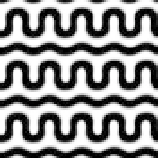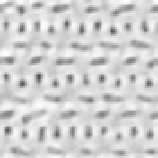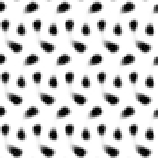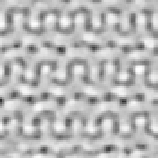Biomedical Engineering Reference
In-Depth Information
(a)
(b)
(c)
(d)
[111]
Figure 2.19
Surface SEM images of porous and relief (211) projections.
(a) SEM image of a porous polymer template and (b) the simulated (211)
porous projection with a unit cell dimension of 47 nm. (c) SEM image of
replicated Ti(IV) oxide nanostructure electrochemically deposited into
the template followed by dissolution of the polymer and (d) comparison
to the (211) simulated relief projection. Reproduced with permission from
Ref. [61].
Over macroscopic-length scales, the order and orientation of
template and replicate was probed using grazing incidence small
angle X-ray scattering (GISAXS) for (I) the porous polymer template,
(II) the electrochemically filled template, and (III) the heat annealed
and contracted array. The patterns for all three stages could be
indexed to a cubic Ia
3d structure oriented with the (211) lattice
vector perpendicular to the substrate. The fitted structures have a
uniaxial compression perpendicular to the substrate, as summarized
in Table 2.2. Remarkably, the periodic ordering is preserved after
TiO
crystallization despite an accumulated compression of 52%.
2
Table 2.2
Gyroid structural compression calculated from GISAXS fitting to
a uniaxially compressed cubic Ī3d structure
Unit cell (nm)
Incremental
compression (%)
Accumulated
compression (%)
49.0
0
Bulk PFS-b-PLA
0
Voided PFS template film
50.5
9
9
Hydrated Ti(IV) oxide film
50.0
13
21
Anatase titania array
50.5
39
52
Both the orientation and high-temperature contraction
confirmed by scattering data can be observed directly in real space
by SEM imaging. Fig. 2.20a,d shows low-magnification SEM cross
sections of a Ti(IV) oxide-filled template before and after annealing


























Search WWH ::

Custom Search